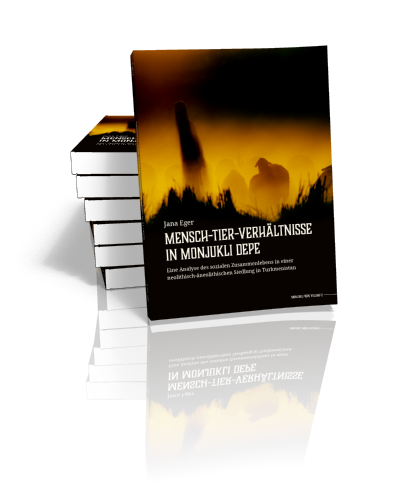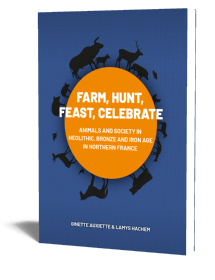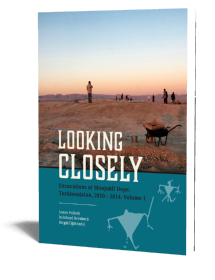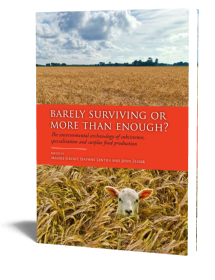Mensch-Tier-Verhältnisse in Monjukli Depe
Eine Analyse des sozialen Zusammenlebens in einer neolithisch-äneolithischen Siedlung in Turkmenistan
Jana Eger | 2022

Mensch-Tier-Verhältnisse in Monjukli Depe
Eine Analyse des sozialen Zusammenlebens in einer neolithisch-äneolithischen Siedlung in Turkmenistan
Jana Eger | 2022
Paperback ISBN: 9789464280180 | Hardback ISBN: 9789464280197 | Imprint: Sidestone Press Dissertations | Format: 210x280mm | 264 pp. | Monjukli Depe Volume 2 | Language: German | 57 illus. (bw) | 17 illus. (fc) | Keywords: archaeology; human-animal studies; social zooarchaeology; aeneolithic; neolithic; Kopet Dag region; faunal remains; zoomorphic figurines; multi-isotopic analysis; interspecies relations | download cover
Read online 131 times
- Digital & Online access
-
Buy via Sidestone (EU & UK)
-
Buy via our Distributors (WORLD)
For non-EU or UK destinations you can buy our books via our international distributors. Although prices may vary this will ensure speedy delivery and reduction in shipping costs or import tax. But you can also order with us directly via the module above.
UK international distributor
USA international distributor
-
Bookinfo
Paperback ISBN: 9789464280180 | Hardback ISBN: 9789464280197 | Imprint: Sidestone Press Dissertations | Format: 210x280mm | 264 pp. | Monjukli Depe Volume 2 | Language: German | 57 illus. (bw) | 17 illus. (fc) | Keywords: archaeology; human-animal studies; social zooarchaeology; aeneolithic; neolithic; Kopet Dag region; faunal remains; zoomorphic figurines; multi-isotopic analysis; interspecies relations | download cover
Read online 131 times

We will plant a tree for each order containing a paperback or hardback book via OneTreePlanted.org.
Wie gestaltete sich das soziale Zusammenleben zwischen Menschen und nichtmenschlichen Arten als eine eng verwobene Gemeinschaft in prähistorischer Zeit? In verschiedensten Disziplinen der Geistes-, Sozial- und Lebenswissenschaften werden verstärkt gesellschaftliche Grundannahmen über nichtmenschliche Arten hinterfragt. Die aus dieser Wende entstandenen neuen Fragestellungen verbreiten sich auch in der Archäologie. Archäolog*innen haben begonnen, traditionelle Ansätze zu überdenken, um Beziehungen zwischen Menschen und (anderen) Tieren in all ihrer Diversität zu erforschen. Im Zuge dieses Perspektivwechsels in der Erforschung von Mensch-Tier-Verhältnissen intensiviert sich auch die Auseinandersetzung mit sozialen, politischen und ideologischen Dimensionen verschiedener Lebensweisen in frühen Gesellschaften. Wir erkennen zunehmend, welche zentrale Rolle Mensch-Tier-Beziehungen bei der Gestaltung und Konstruktion auch prähistorischer Gesellschaften eingenommen haben.
In diesem Band wird das gängige archäologische Narrativ von Tieren als passiver, ausbeutbarer Nahrungsressource in Frage gestellt. Damit zeichnet das Buch ein komplexes Bild prähistorischer Mensch-Tier-Verhältnisse. Es legt eine multiperspektivische Studie zu soziokulturellen Praktiken und Vorstellungen damaliger Menschen anhand der spätneolithischen (ca. 6200-5600 v.u.Z) und frühäneolithischen (ca. 4800-4350 v.u.Z.) Siedlung Monjukli Depe im heutigen Turkmenistan vor, die sich von gegenwärtigen westlichen Kategorisierungsformen der Beziehungen zwischen Menschen und Tieren deutlich unterscheiden. Auf Basis einer umfangreichen Sammlung von rund 53.000 Tierknochen aus den Ausgrabungen in Monjukli Depe verfolge ich als analytischen Untersuchungsrahmen einen integrativen Ansatz, der 1.) die archäozoologische Untersuchung der faunalen Überreste, 2.) die Analyse der zoomorphen Repräsentationen als miniaturisierte Tonobjekte sowie 3.) Multi-Isotopenanalysen am ausgewählten Skelettmaterial kombiniert.
Das Werk zeigt Wege auf, natur- und kulturwissenschaftliche Sichtweisen in einem analytischen Spektrum an Methoden so zu integrieren, dass Interspezies-Relationen in vergangenen Gemeinschaften holistischer und damit realistischer als bislang rekonstruiert werden können. Die Neubetrachtung der Gemeinschaft als Interspezies-Gebilde stellt den innovativen Ansatz schließlich in einen gesellschaftspolitischen Rahmen. Der Band bietet damit auch einen Referenzrahmen für multiperspektivisch ausgerichtete Untersuchungen von Interspezies-Relationen.
English Abstract
How did the social coexistence of humans and non-human species contribute to the formation of interwoven communities in prehistoric times? In various disciplines in the humanities, social and life sciences, assumptions regarding non-human species in societal contexts are coming increasingly under scrutiny. The new questions arising therefrom are spreading into archaeology, where scholars have started to rethink traditional approaches and explore practices, interactions, and relationships between humans and (other) animals. As part of this shift in perspective, more attention is being paid to social, political, and ideological dimensions of lifeways in early societies. With it comes a growing recognition that human-animal relationships occupied a central place in shaping and constructing societies throughout human history.
This book presents a multi-perspectival study of socio-cultural practices and conceptions of the people who lived in the prehistoric settlement of Monjukli Depe (Turkmenistan). These differ significantly from contemporary Western categorizations of human-animal relations. Based on a collection of over 50,000 animal remains from the excavations at Monjukli Depe, I pursue an integrative approach that includes 1) zooarchaeological studies of faunal remains, 2) analyses of zoomorphic representations in the form of miniaturized clay objects, and 3) multi-isotopic analyses of selected skeletal material.
I suggest ways to integrate scientific and socio-cultural perspectives into an analytical spectrum of methods, enabling interspecies relations in past communities to be reconstructed more holistically and thereby more realistically than has previously been the case. The volume provides a work for future investigations of interspecies relations in other geographic and temporal contexts.
Danksagung
Abbildungsverzeichnis
Tabellenverzeichnis
1. Einleitung
2. Theoretischer Rahmen
3. Forschungsüberblick
4. Monjukli Depe und die Tiere
5. Monjukli Depe und die figürliche Darstellung von Tieren
6. Monjukli Depe und die Lebensweise von Schafen/Ziegen
7. Diskussion: Mensch-Tier-Dynamiken in Monjukli Depe
8. Literaturverzeichnis
9. Anhang

Dr. Jana Eger
Jana Eger is an archaeologist specialized in zooarchaeological and isotopic analysis of animal remains to understand how the social coexistence of humans and non-human species contribute to the formation of communities of people and (other) animals in past societies. While pursuing a B.A. and M.A. at the Institute of Near Eastern Archaeology at the Freie Universität (FU) Berlin, she spent study visits in Rome (ERASMUS at La Sapienza) and at Cornell University in Ithaca (N.Y., US:A) with a grant from the PROMOS program. She completed her doctorate at the FU Berlin within the framework of the Berlin Graduate School of Ancient Studies (BerGSAS) in the program: Landscape Archaeology and Architecture. During her academic career she participated in various field projects, i.e., in Turkmenistan, Iran and Germany. Currently, she is working as a post-doctoral researcher in the DFG-Project ISOSIBERIA based at the Eurasia Department of the German Archaeological Institute.
Abstract:
Wie gestaltete sich das soziale Zusammenleben zwischen Menschen und nichtmenschlichen Arten als eine eng verwobene Gemeinschaft in prähistorischer Zeit? In verschiedensten Disziplinen der Geistes-, Sozial- und Lebenswissenschaften werden verstärkt gesellschaftliche Grundannahmen über nichtmenschliche Arten hinterfragt. Die aus dieser Wende entstandenen neuen Fragestellungen verbreiten sich auch in der Archäologie. Archäolog*innen haben begonnen, traditionelle Ansätze zu überdenken, um Beziehungen zwischen Menschen und (anderen) Tieren in all ihrer Diversität zu erforschen. Im Zuge dieses Perspektivwechsels in der Erforschung von Mensch-Tier-Verhältnissen intensiviert sich auch die Auseinandersetzung mit sozialen, politischen und ideologischen Dimensionen verschiedener Lebensweisen in frühen Gesellschaften. Wir erkennen zunehmend, welche zentrale Rolle Mensch-Tier-Beziehungen bei der Gestaltung und Konstruktion auch prähistorischer Gesellschaften eingenommen haben.
In diesem Band wird das gängige archäologische Narrativ von Tieren als passiver, ausbeutbarer Nahrungsressource in Frage gestellt. Damit zeichnet das Buch ein komplexes Bild prähistorischer Mensch-Tier-Verhältnisse. Es legt eine multiperspektivische Studie zu soziokulturellen Praktiken und Vorstellungen damaliger Menschen anhand der spätneolithischen (ca. 6200-5600 v.u.Z) und frühäneolithischen (ca. 4800-4350 v.u.Z.) Siedlung Monjukli Depe im heutigen Turkmenistan vor, die sich von gegenwärtigen westlichen Kategorisierungsformen der Beziehungen zwischen Menschen und Tieren deutlich unterscheiden. Auf Basis einer umfangreichen Sammlung von rund 53.000 Tierknochen aus den Ausgrabungen in Monjukli Depe verfolge ich als analytischen Untersuchungsrahmen einen integrativen Ansatz, der 1.) die archäozoologische Untersuchung der faunalen Überreste, 2.) die Analyse der zoomorphen Repräsentationen als miniaturisierte Tonobjekte sowie 3.) Multi-Isotopenanalysen am ausgewählten Skelettmaterial kombiniert.
Das Werk zeigt Wege auf, natur- und kulturwissenschaftliche Sichtweisen in einem analytischen Spektrum an Methoden so zu integrieren, dass Interspezies-Relationen in vergangenen Gemeinschaften holistischer und damit realistischer als bislang rekonstruiert werden können. Die Neubetrachtung der Gemeinschaft als Interspezies-Gebilde stellt den innovativen Ansatz schließlich in einen gesellschaftspolitischen Rahmen. Der Band bietet damit auch einen Referenzrahmen für multiperspektivisch ausgerichtete Untersuchungen von Interspezies-Relationen.
English Abstract
How did the social coexistence of humans and non-human species contribute to the formation of interwoven communities in prehistoric times? In various disciplines in the humanities, social and life sciences, assumptions regarding non-human species in societal contexts are coming increasingly under scrutiny. The new questions arising therefrom are spreading into archaeology, where scholars have started to rethink traditional approaches and explore practices, interactions, and relationships between humans and (other) animals. As part of this shift in perspective, more attention is being paid to social, political, and ideological dimensions of lifeways in early societies. With it comes a growing recognition that human-animal relationships occupied a central place in shaping and constructing societies throughout human history.
This book presents a multi-perspectival study of socio-cultural practices and conceptions of the people who lived in the prehistoric settlement of Monjukli Depe (Turkmenistan). These differ significantly from contemporary Western categorizations of human-animal relations. Based on a collection of over 50,000 animal remains from the excavations at Monjukli Depe, I pursue an integrative approach that includes 1) zooarchaeological studies of faunal remains, 2) analyses of zoomorphic representations in the form of miniaturized clay objects, and 3) multi-isotopic analyses of selected skeletal material.
I suggest ways to integrate scientific and socio-cultural perspectives into an analytical spectrum of methods, enabling interspecies relations in past communities to be reconstructed more holistically and thereby more realistically than has previously been the case. The volume provides a work for future investigations of interspecies relations in other geographic and temporal contexts.
Contents
Danksagung
Abbildungsverzeichnis
Tabellenverzeichnis
1. Einleitung
2. Theoretischer Rahmen
3. Forschungsüberblick
4. Monjukli Depe und die Tiere
5. Monjukli Depe und die figürliche Darstellung von Tieren
6. Monjukli Depe und die Lebensweise von Schafen/Ziegen
7. Diskussion: Mensch-Tier-Dynamiken in Monjukli Depe
8. Literaturverzeichnis
9. Anhang

Dr. Jana Eger
Jana Eger is an archaeologist specialized in zooarchaeological and isotopic analysis of animal remains to understand how the social coexistence of humans and non-human species contribute to the formation of communities of people and (other) animals in past societies. While pursuing a B.A. and M.A. at the Institute of Near Eastern Archaeology at the Freie Universität (FU) Berlin, she spent study visits in Rome (ERASMUS at La Sapienza) and at Cornell University in Ithaca (N.Y., US:A) with a grant from the PROMOS program. She completed her doctorate at the FU Berlin within the framework of the Berlin Graduate School of Ancient Studies (BerGSAS) in the program: Landscape Archaeology and Architecture. During her academic career she participated in various field projects, i.e., in Turkmenistan, Iran and Germany. Currently, she is working as a post-doctoral researcher in the DFG-Project ISOSIBERIA based at the Eurasia Department of the German Archaeological Institute.
- Digital & Online access
-
Buy via Sidestone (EU & UK)
-
Buy via our Distributors (WORLD)
For non-EU or UK destinations you can buy our books via our international distributors. Although prices may vary this will ensure speedy delivery and reduction in shipping costs or import tax. But you can also order with us directly via the module above.
UK international distributor
USA international distributor
- Browse all books by subject
-
Search all books

We will plant a tree for each order containing a paperback or hardback book via OneTreePlanted.org.
You might also like:
© 2025 Sidestone Press KvK nr. 28114891 Privacy policy Sidestone Newsletter Terms and Conditions (Dutch)








